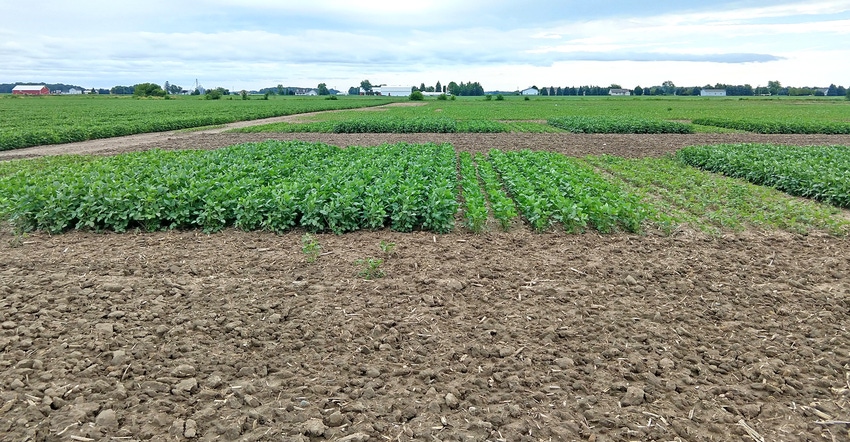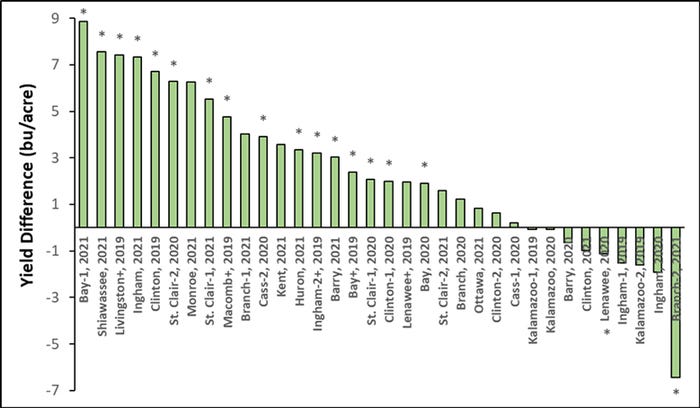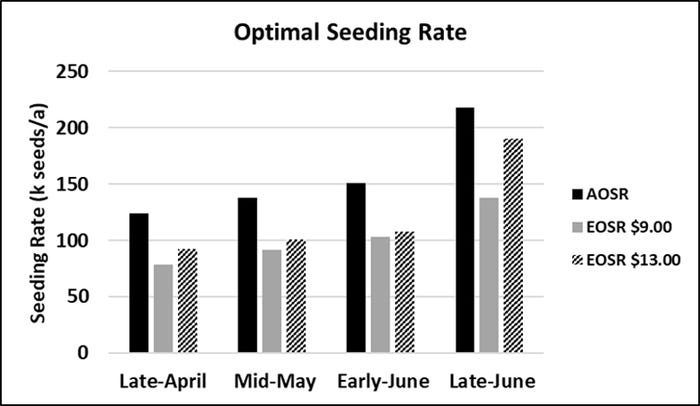May 9, 2022

Soybean planting date has been shown to have a large impact on a crop’s yield potential. Typically, early-season soybean planting has shown improved yields compared to when planting is delayed.
However, it is largely unknown how other management practices should be adjusted based on planting date in Michigan. Michigan State University Extension has conducted both on-farm and small-plot research from 2018 to 2021 to better understand not only how soybean planting date affects yield, but also how other management decisions might change based on planting date.
Planting date
On-farm trials were conducted to compare early-season soybean planting dates with normal soybean planting dates in 2019, 2020 and 2021. Growers were asked to plant soybean three weeks apart in a randomized strip trial design with four replications and collect yield data from each strip.
Early-season planting resulted in significantly higher yields at five out of nine locations in 2019 (average yield increase of 2.6 bushels per acre, some fields had in-season pesticide application along with early planting), at five out of 12 fields in 2020 (average yield increase of 1.2 bushels per acre), and at seven out of 13 fields in 2021 (average yield increase of 3.4 bushels per acre). One field in 2021 reported significant yield loss from ultra-early planting (April 8), indicating potential risks associated with such plantings.

Figure 1. Yield difference (early through typical planting, separated by around three weeks) across various Michigan locations during the 2019-21 growing seasons. *Denotes locations with significant yield differences. +Denotes 2019 locations with fungicide/ insecticide spray at R3 (beginning pod) in early planting. Branch-2, 2021 utilized an ultra-early planting date (April 8).
Small plot research trials were conducted between 2018 and 2021 using 3 to 4 planting dates ranging from late April to late June. Results from these studies show that optimal soybean planting is during or before mid-May.
Delayed planting after mid-May resulted in a yield penalty, which increased as planting was delayed. On average, soybean yield was reduced by 0.33% per day between the mid-May and early-June planting dates. Furthermore, planting after early June resulted in an average yield reduction of 1.2% per day.
Overall, the results from these studies suggest that avoiding delayed soybean planting is critical to maximizing yield potential. Moreover, other management decisions might need to change based on planting date to maximize yield and minimize input costs.
Maturity group
Results from research conducted over four site years showed that the benefits of early-season soybean planting can be improved (with more than 3 bushels per acre advantage) by using a variety with a later maturity group designation.
Furthermore, when planting was delayed to late June, using an early-maturity variety not only provided a small yield advantage, but also resulted in soybean seed with low moisture content at the time of harvest.
The use of a later-maturing variety combined with an early-season planting increases the amount of growing degree day accumulation during vegetative and reproductive stages and resulted in a greater number of seeds per unit area without reducing seed weight, leading to yield increase.
Seeding rate
Research results over four site years showed that the seeding rate that maximizes net income is lower compared to the seeding rate that maximizes yield, and optimal seeding rates are dependent on planting date.
Maximum yield was achieved from using a seeding rate of 124,000 seeds per acre during the late-April planting date, 138,000 seeds per acre during the mid-May planting date, 151,000 seeds per acre during the early-June planting date, and 218,000 seeds per acre during the late-June planting date.
However, maximum net income (calculated using $9 per bushel soybean, $65 per unit treated seed) was achieved using lower seeding rates for all planting dates. Specifically, seeding rates of 79,000 seeds per acre during late April, 92,000 seeds per acre during mid-May, 103,000 seeds per acre during early June, and 138,000 during late June achieved maximum net income. So, these rates were at least 45,000 seeds lower than the ones to achieve maximum yield.
Even with higher soybean prices, seeding rates that maximize income increase only by about 10,000 seeds compared to the $9-per-bushel price point, except for late-June planting. This suggests that the optimal seeding rate may be lower compared to what is currently being used by growers. Furthermore, increasing soybean seeding rates as planting is delayed into mid-June can help mitigate losses of yield and net returns associated with delayed planting.

Figure 2. Soybean seeding rates that resulted in the maximum yield (agronomically optimal seeding rate, AOSR; black bars), profit at a selling price of $9.00 (economically optimum seeding rate, EOSR at $9; gray bars), and profit at a selling price of $13.00 (EOSR at $13, striped bars) during late-April, mid-May, early-June, and late-June planting dates.
Row spacing
Results from trials conducted in 2021-22 showed that narrow rows (15-inch) increased yield by about 10% over wider (30-inch) row spacing. There was no planting date x row spacing interaction, meaning yield increase with narrow over wider rows was consistent regardless of the planting date.
Seeding rates ranging from 40,000 to 190,000 seeds per acre were also evaluated in both row spacings under early and typical planting time. Results showed that agronomic as well as economic optimal seeding rate did not differ between the two row spacings.
Averaged across row spacing, economic optimal seeding rate was 121,200 seeds per acre for late-April planting and 112,400 seeds per acre for mid-May planting. Delayed planting (in to mid-June) benefited more from increase in seeding rate under narrow that wider rows.
Planting in 15-inch row spacing allows for quicker canopy closure and increased light interception compared to 30-inch row spacing, which can increase yield. However, this canopy also provides an ideal environment for diseases such as white mold. One way to reduce disease pressure in narrow-row soybeans is to reduce seeding rate for more airflow throughout the canopy.
Seed treatment
The use of a complete seed treatment (insecticide, fungicide, nematicide) did not result in improved yields in trials conducted at four site years, regardless of planting date. However, using the seed treatment did improve plant stands at the Mason location. The lack of yield improvement from using the seed treatment resulted in a $10.52 per acre reduction in net income compared to the non-treated control when averaged across these locations and years.
It should be noted however that there are many conditions where a seed treatment is beneficial. Specifically, when planting into cooler, wet soils (which is more common during early-season soybean planting), a seed treatment can help prevent excessive stand loss to early-season pests and diseases such as bean leaf beetle, seed corn maggot, sudden death syndrome, and seed decay and damping off. An additional reason for planting seed treated with a base seed treatment (multiple fungicides and an insecticide) is to obtain the replant coverage offered by some seed companies.
In fields with a known history of pest pressure, it can be beneficial to increase seeding rates to account for reduced plant stands. However, increasing seeding rate may not be necessary if a seed treatment is used. Choosing to implement both of these management practices may greatly reduce pest issues, but can reduce overall net income because of increased input cost.
Key findings
The results from this research suggest that:
Early-season soybean planting has the potential to improve yield. Delayed soybean planting can reduce yield by up to 1.2% per day if planting occurs after early June.
Using a later-maturing variety (longer maturity group designation) can further build upon the benefits of early-season planting, including yield improvements, without adding extra cost.
Soybean seeding rates should be adjusted based on planting date. Specifically, seeding rates should be increased as planting is delayed. Also, using lower seeding rates when planting earlier in the season might yield less, but will have reduced input costs and can increase maximum net income.
Narrow rows increased yield over 30-inch row spacing across all planting dates. Optimal seeding rate for narrow rows was not higher than that of wider rows.
Seed treatments are most beneficial when there are pests present in the seed bed, especially during early-season planting.
For more information on our research, visit the MSU Cropping Systems Agronomy website.
Singh and Siler write for Michigan State University Extension, Department of Plant, Soil and Microbial Sciences.
Source: MSU Extension, which is solely responsible for the information provided and is wholly owned by the source. Informa Business Media and all its subsidiaries are not responsible for any of the content contained in this information asset.
You May Also Like




